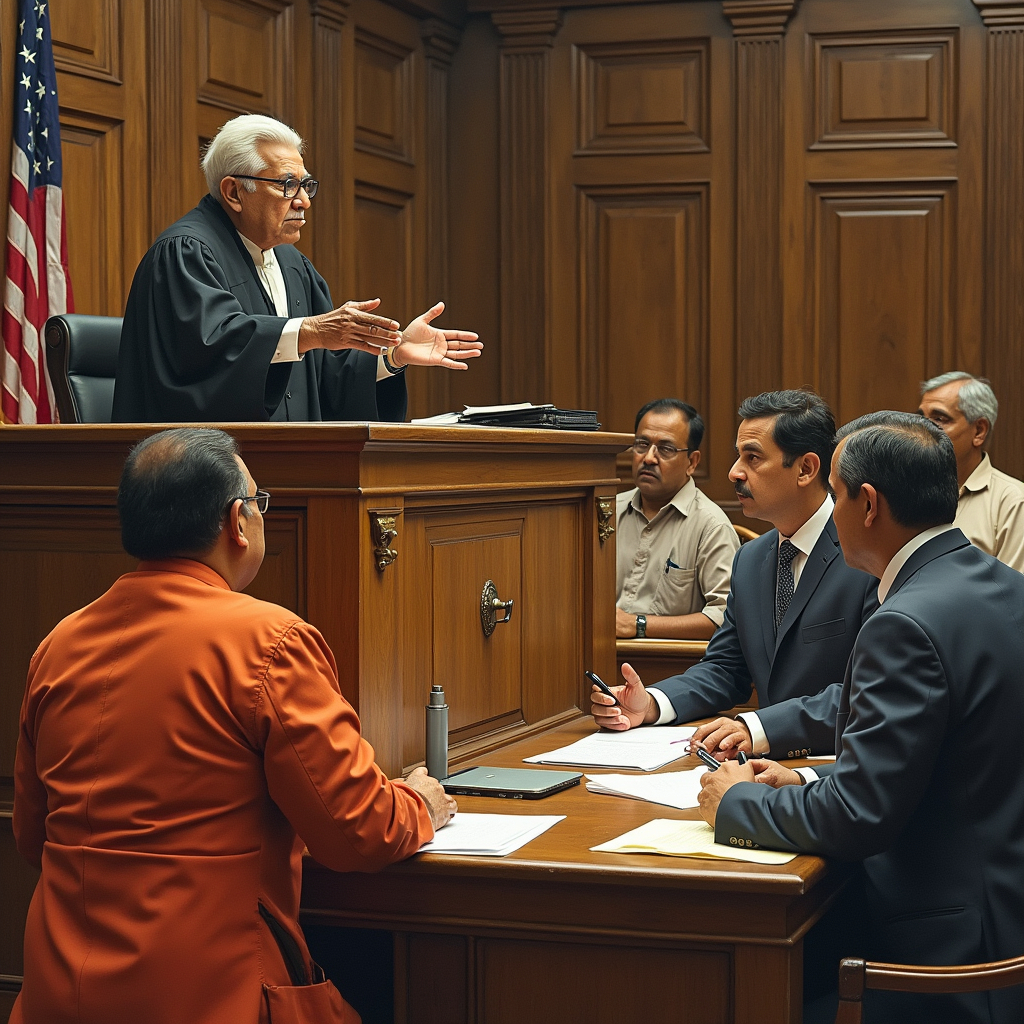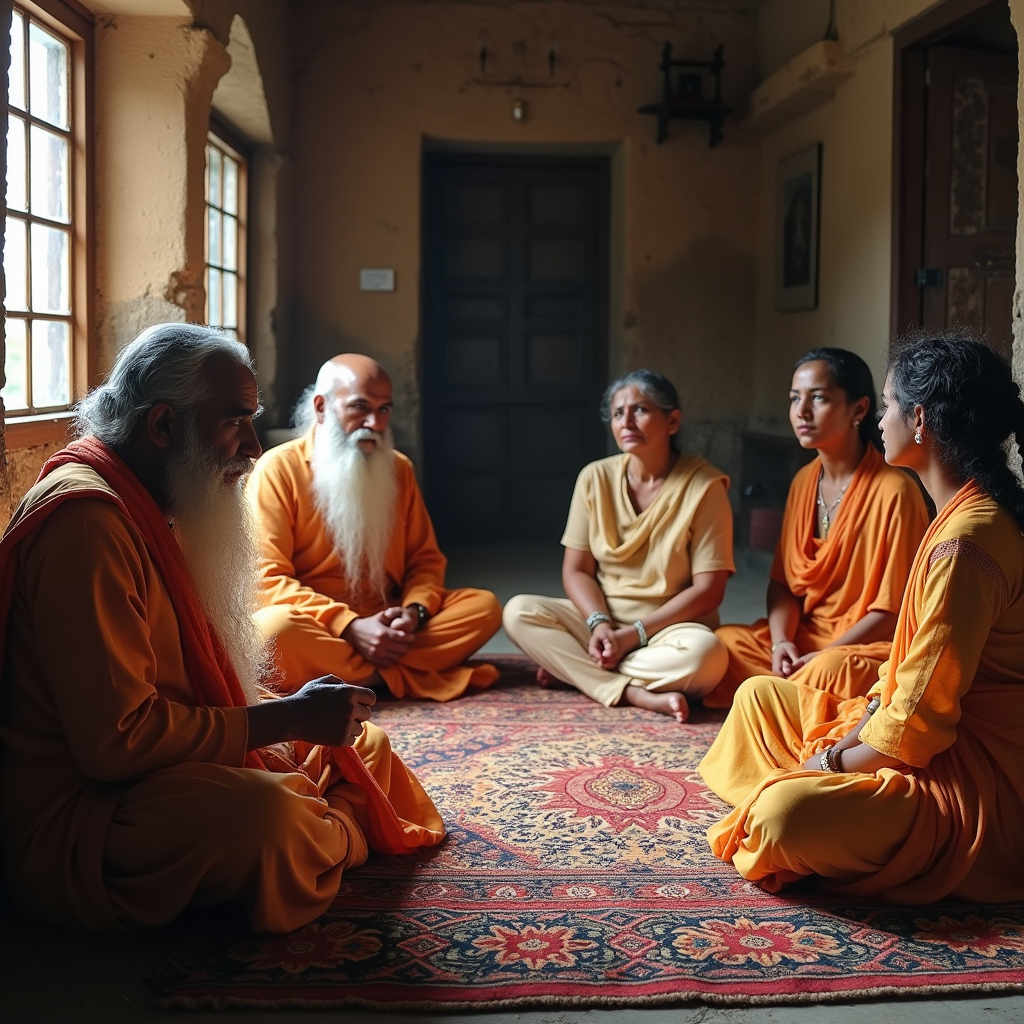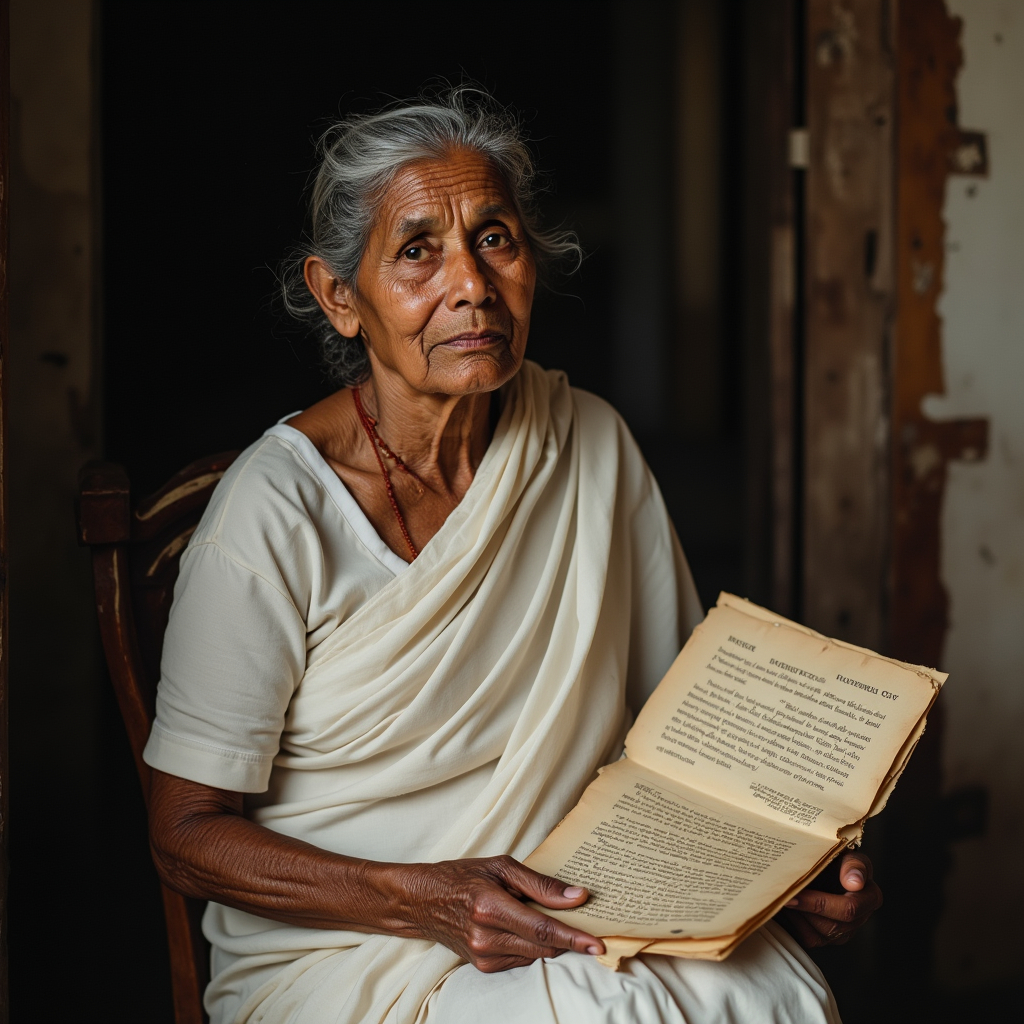This article is written by Subhangee Biswas. The article discusses the judgement of Smt. Indrakali vs. Ravi Bhan Prasad (2012) in the backdrop of ancestral property and the doctrine of blending in Hindu law. It proceeds to cover the facts of the case that gave rise to the dispute and then leads to the issues formulated by the court along with the submissions made by both parties. The article also discusses in detail the legal concepts involved and the precedents mentioned before concluding with the judgement pronounced by the Madhya Pradesh High Court and an overall analysis of the entire judgement.
Table of Contents
Introduction
There are two types of properties that a person possesses, one which is passed down from the male ancestors through inheritance called the ancestral property, and another is the self-acquired property which a person builds during his lifetime. It is also known as personal property.
In general, ancestral property is inherited by birth and self-acquired property is inherited through transfer. The self-acquired property also becomes an inheritable property under certain circumstances. If a Hindu dies intestate leaving his self-acquired property behind unattended, such self-acquired property would be shared among his legal heirs as per the Hindu Succession Act, 1956. Another way in which self-acquired property can be inherited is when self-acquired property is blended with ancestral property, i.e., the person has to independently merge his acquired property with the joint family property so that such personal property becomes a part of the ancestral property.
This particular case of Smt. Indrakali vs. Ravi Bhan Prasad (2012) is concerned with the self-acquired property belonging to a Hindu female who had received the same from her father by way of a gift. This self-acquired property belonged to the plaintiff’s sister-in-law and it was claimed to have been merged with ancestral property liable to be inherited by the two brothers-in-law. Thereafter, a suit for declaration and possession was filed by them contesting the claim over the property.
The case revolves around the question of whether a property acquired by a Hindu female, by the way of a gift from her father, could be taken to have formed a part of the ancestral property. The Madhya Pradesh High Court considered the facts and after applying the principles of Hindu law related to property and inheritance, came to the conclusion that such acquired property of the female, being her stridhan, could not be merged with the ancestral property. The Court also analysed the doctrine of blending in this context while also deciding on the extent of the application of the limitation period for the filing of the suit.
Details of the case
- Case name: Smt. Indrakali vs. Ravi Bhan Prasad
- Case number: Second appeal number 495 of 1994
- The statutes involved: The Limitation Act, 1963.
- Appellant: Indrabhan, represented by his legal representatives after his demise.
- Respondents: Ravi Bhan Prasad.
- Court: High Court of Madhya Pradesh.
- Bench: Justice A. K. Shrivastava.
- Judgement date: 15th September 2011
Background of the case
The case of Smt. Indrakali vs. Ravi Bhan Prasad (2012) discusses the concept blending of self-acquired property with the ancestral property. The self-acquired property mentioned in this case was actually the stridhan of a Hindu female. The same contended to have been merged into the ancestral property.
The case also discusses a few Articles mentioned in Mulla’s Hindu Law (21st edition) and their application in the present case. Mulla’s Hindu Law is a treatise on the concepts of Hindu personal law like marriage, divorce and inheritance.
Apart from the legal aspects related to joint family property, the case also discusses the law of limitation and its application when the title to the property has been perfected by the opposing party via adverse possession.
Facts of the case
Background facts
Ravibhan Prasad (the plaintiff in the original suit and respondent no.1 in the present appeal; hereinafter referred to as ‘respondent no.1’) has two brothers, his real brother named Indrabhan (the defendant no.1 in the original suit, hereinafter referred to as the defendant) and another elder brother named Suryabhan. Suryabhan died in 1946.
The father-in-law of Suryabhan, named Ramsanehi, was the owner of the property. Ramsanehi had transferred the property to his daughter, i.e., the wife of Suryabhan. It also contained certain ancestral properties belonging to the parties.
After the death of Suryabhan, the defendant Indrabhan, being the immediate elder brother, mutated the suit property in his name. However, both the brothers Indrabhan and Ravibhan had possession of the property.
Both the suit property and the ancestral property were partitioned between the two remaining brothers in 1964 and they were in the possession of their respective shares since the said partition. According to the claim made by respondent no.1, he received the suit property as his share and had its possession.

In 1988, the defendant Indrabhan forcibly dispossessed respondent no.1 from the suit property. Then, respondent no.1 assembled a Panchayat. After conciliation, the suit property was given back to respondent no.1. Again, defendant Indrabhan took illegal possession of the suit property by forcing out respondent no.1 from the property.
Filing of the suit for declaration and possession
A suit for declaration and possession of the suit property was filed by respondent no.1 on November 3, 1988. After the suit was filed by respondent no.1, Indrabhan filed a written statement wherein he denied all the allegations made by respondent no.1 and alleged that respondent no.1 was not the owner of the suit property, that the property was transferred to him and that there was no partition. Further, defendant Indrabhan also presented a plea of adverse possession of the suit property and claimed that the suit was time-barred.
Proceedings before the Trial Court
The Learned Trial Court dismissed the suit on merits and the grounds of limitation. It held that the suit was barred by time and that defendant Indrabhan had gained “bhumiswami right” by adverse possession of the suit property.
Appeals following the dismissal by the Trial Court
Respondent no.1 filed a first appeal against the judgement of the Trial Court. The same was allowed and hence the judgement of the Trial Court was reversed.
Then, defendant Indrabhan filed a second appeal in the High Court of Madhya Pradesh against the judgement of reversal.
During the pendency of the second appeal, defendant Indrabhan died and his legal representatives substituted him (hereinafter referred to as ‘the appellants’).
Issues involved in the case
The court admitted the appeal on January 21, 2011, and the following issues arose before the court:
- Whether the property inherited by a daughter, in the form of a gift from her father, is classified as ancestral property?
- Whether the original suit filed by respondent no.1 was within the limitation period?
Arguments by the parties
Arguments by the appellant
Contentions regarding issue no. 1
The learned counsel for the appellants reiterated the following contentions presented by respondent no.1:
- The property in suit was originally owned by Suryabhan (the eldest brother) and his wife.
- Both Suryabhan and his wife died issueless.
- The property in suit was inherited by the wife of Suryabhan from her father in the form of a gift.
Based on the same, the learned counsel for the appellants made the following submissions:
- Since the suit property was acquired by the wife as a gift from her father, in the absence of any child of their own, the suit property would be transferred to the male members of her husband’s family.
- It was also submitted that the suit property could not be considered to be an ancestral property.
- Article 221(3) of Mulla’s Hindu Law (21st edition) was referred to and it was stated that property inherited from collaterals (example: brother, uncle) or from a female (example: mother) falls under the category of the person’s separate property and not ancestral property.
- Article 126 of Mulla’s Hindu Law (21st edition) was referred to and it was stated that property gifted to a female by her parents falls under the category of her stridhan and that property cannot be included in the ancestral property.
- Article 225 of Mulla’s Hindu Law (21st edition) was referred to and it was submitted that the doctrine of coparcenary could not be applied to a Hindu female acquiring property from her father since the female is not counted as a coparcener.
Concluding the submissions in this regard, the learned counsel claimed that the plea of respondent no.1 that the property of the wife (wife of Suryabhan and daughter of Ramsanehi) could not be put together with the ancestral property of the husband’s family. Thus, the suit property could not be partitioned.
Contentions regarding issue no. 2
The learned counsel for the appellants submitted that the original suit filed on November 3, 1988, was ex facie barred by time. The reason provided behind such contention was that respondent no.1 was not in possession of the suit property 12 years prior to the date of the filing of the original suit. As a result, the Appellate Court had made an error in holding that the original suit was filed within limitation. Moreover, the learned counsel added that the Trial Court had observed that the suit was time-barred.
It was thus prayed that the judgement passed by the learned first appellate court be set aside and the judgement and decree of the Trial Court be restored and upheld.

Arguments by respondent
Contentions regarding issue no. 1
The learned counsel for the respondent presented the following contentions regarding issue no. 1:
- Defendant Indrabhan had admitted in his written statement filed in the original suit and had claimed the same in the present suit that the suit property was a subject matter besides the other immovable properties.
- Defendant Indrabhan had admitted in his written statement that the suit property was merged with the ancestral property and then the property was partitioned between respondent no.1 and defendant, i.e., Ravibhan and Indrabhan respectively.
- In the partition of the properties, the suit property fell in the share of respondent no.1, Ravibhan.
- Defendant Indrabhan shall not be allowed to go back on his own admissions made in his written statement filed in the original suit.
The learned counsel concluded that since the question of whether the suit property can be included in the category of ancestral property has been settled in the earlier proceedings, the same could not be re-adjudicated.
Contentions regarding issue no. 2
Regarding the issue of limitation, the learned counsel for the respondent had submitted the following:
- The learned first appellate court was not erred in holding that the suit was within the limitation period.
- As observed by the first appellate court in its judgement, the testimony by the witnesses from the side of respondent no.1 has collectively led to the opinion that respondent no.1 had possession of the suit property from 1964 to 1988. Thus, the suit filed on November 3, 1988, cannot be claimed as time-barred.
The learned counsel for the respondents presented the above-mentioned contentions and prayed that the appeal be dismissed.
Legal concepts involved in Smt. Indrakali vs. Ravi Bhan Prasad (2012)
Article 221 of Mulla’s Hindu Law (21st edition)
As mentioned earlier, Article 221(3) of Mulla’s Hindu Law discusses the property inherited from collaterals. It states that property inherited from females in a family is termed as the property inherited from collaterals. The exception in this case is when property is inherited from maternal grandfather.
Regarding what property can be called and included under the term “ancestral property”, it has been mentioned that the property which is inherited by a person from their male ascendants, like, father, father’s father, father’s father’s father, and so on, is to be considered under ancestral property. In simple terms, property inherited from the male lineage is called ancestral property.
Property inherited by a person from any other relation constitutes separate property of that person. In this case, the person’s male offspring would not have any interest in the separate property by birth.
Therefore, property inherited from collaterals, like brother or uncle, and those inherited from a female, like mother or aunt, all constitute separate property.
Article 126 of Mulla’s Hindu Law (21st edition)
This Article mentions will and bequests from familiar relationships. It states that if a property has been gifted to a female offspring by her parents, it would be considered as her stridhan. Since the property is her stridhan and since a Hindu female is also not considered a coparcener in a joint family property, her stridhan cannot be blended into the ancestral property.
Article 225 of Mulla’s Hindu Law (21st edition) and Article 225 (2a)
The judgement mentions Article 225(1) and Article 225(2a) while discussing the blending of personal property with ancestral property is not a possibility.
Article 225(1) mentions property thrown into common stock. The Article states that a separate or self-acquired property of a coparcener in a joint family may become joint family property through the application of the doctrine of blending if such property has been voluntarily merged into the common property with the intention to renounce all separate claims on such property.
The most important element to be established is the clear intention to waive the separate rights. Acts of kindness or generosity are not to be interpreted as acceptance of legal obligation. It is not to be concluded from facts like:
- The person has allowed the other family members to use such personal property together with him; or,
- That some income from the separate property was used to provide for a son; or,
- The failure of a member to keep separate accounts of his income.
The fact that the individual has permitted other coparceners to use his self-acquired property does not lead to the presumption that the separate property becomes a part of the joint family property unless the person expressly throws such property into common stock.

The occurrence of throwing self-acquired property into common stock depends on all the incidents of joint family property.
Article 225(2a) states that the basis of the doctrine of blending is the existence of coparcenary, coparcenary property and separate property of a coparcener. Moreover, it has been expressly stated that the doctrine of blending cannot be applied to a Hindu female acquiring immovable property from her father since a Hindu female is not considered to be a coparcener under the Mitakshara school of Hindu law.
The fact that a Hindu female is not a coparcener and that the doctrine of blending does not apply to a Hindu female was also reaffirmed by the Supreme Court, as mentioned later in the present judgement.
Coparcener and doctrine of coparcenary
Hindu law defines a coparcener as a member of a Hindu Undivided Family having an interest in the joint family property by birth. Such a right is a legal right and the coparceners are joint heirs to the ancestral property. The coparceners have a right to demand partition of the ancestral property.
Before 2005, the daughters of a family were not considered coparceners. They were just members of the family. The Hindu Succession (Amendment) Act, 2005 removed the gender-based provisions and included daughters under the term of coparceners. After the amendment, the daughters were given the same rights and liabilities to the same extent as that of the male members.
Coparcenary in Hindu law extends to four descending generations in the lineage, i.e., the common ancestor and three generations under him. The fourth generation would only be a coparcener once the highest common ancestor dies.
The doctrine of coparcenary refers to the co-ownership of ancestral property by the coparceners in a Hindu Undivided Family. The ancestral property is owned jointly and enjoyed by all the members of the family, with the coparceners having the inherent right by birth to demand a partition of their portion.
To learn more about coparcenary under Hindu law, click here.
Ancestral property and self-acquired property
Ancestral property
Ancestral property, as the name suggests, means all the properties that are inherited through male ancestors of a joint family. It is also known as “coparcenary property”. As per Hindu law, only male members are considered coparceners, which means, only the male members have an interest in the joint family property by birth. The daughters of the family were not given any right to claim a share in the joint family property till 2005. With the enactment of the Hindu Succession (Amendment) Act, 2005, daughters were given the same status as sons with regard to having an interest in the joint family property by birth.
Ancestral property is inherited from the paternal side. The property inherited by a Hindu male from the preceding three generations, i.e., father, father’s father, father’s father’s father is considered to be ancestral property. Similarly, succeeding three generations of a common ancestor, i.e., children, grandchildren and great-grandchildren, are considered to have developed an interest in that property by birth. Ancestral property is limited to the male lineage and such interest comes into existence by birth.
Property inherited from female ancestors, indirect male lineage, i.e., uncles and brothers, does not fall under the scope of ancestral property.
Self-acquired property
self-acquired property is also known as personal property or separate property. It refers to all those assets that an individual acquires in his lifetime. Such a property may have been acquired by purchase, gift, will, or any other form of transfer. The successors do not acquire any rights to the self-acquired property and the only way self-acquired property is distributed among the legal heirs following rules of succession is when the Hindu dies intestate, i.e., without a Will. However, the owner reserves the right to sell, transfer or mortgage such self-acquired property in the manner they wish to.
Doctrine of blending
The doctrine of blending postulates that when a coparcener blends their separate personal property with the joint Hindu family property willingly, the property becomes a part of the joint family property. The exclusive control and the individual rights that the particular coparcener had over his separate property will stand extinguished and all the coparceners will have a right over the same since the property is now merged with the joint property. Article 225(1) of Mulla’s Hindu Law describes the same phenomenon as “property thrown into common stock” which has been mentioned and discussed above.

Concept of stridhan
The word ‘stridhan’ has been derived from two words: ‘stri’ meaning woman and ‘dhana’ meaning property in sanskrit. As the term suggests, stridhan means property of a woman over which she has absolute rights. Stridhan does not necessarily have to be land or property, it can be any form of asset, including cash, ornaments, land, i.e., any kind of movable or immovable property.
In Hindu law, stridhan consists of everything a woman receives during her lifetime. All the movable and immovable property that a woman receives before her marriage, at the time of her marriage, after marriage, during childbirth or after the death of her husband, all constitute stridhan. It is a voluntary gift given to a woman.
To learn more about stridhan, click here.
Mutation
Mutation is the process of updating the details of the owner of a property in the government records. When a property is sold or transferred, the details relating to that property are changed in the land revenue department. This is known as mutation. Mutation helps the locals as well as authorities to figure out the owner of the property and accordingly fix tax liability and charge the same.
Whenever there is a change or transfer of ownership by sale or inheritance or even by power of attorney, the change has to be reflected in the revenue records through mutation.
To learn more about mutation of property, click here.
Adverse possession
Adverse possession is a legal principle that allows someone to gain ownership of land or property belonging to someone else. Adverse possession is also known as “squatter’s rights” or “homesteading”.
In adverse possession, the title is acquired without the previous owner’s permission. According to this doctrine, when a person has the possession of a property, the ownership of which belongs to some other person, for a continuous and uninterrupted period of 12 years, the person having the possession becomes the lawful owner of that property.
To learn more about it click here.
Bhumiswami rights
Bhumiswami in general means the owner of the land. The ownership may not be absolute considering Section 57 of the Madhya Pradesh Land Revenue Code, 1959 states that the state government is the owner of all of the land but apart from the state government, the person termed as bhumiswami is the owner against other persons.
The term bhumiswami has been defined under the Madhya Pradesh Land Revenue Code, 1959 under Sections 157 and 158.
Before understanding the term “bhumiswami”, we need to understand the term “tenure-holder”. According to Section 2(1)(z), “tenure-holder” means a person who holds land from the state government and is considered to be bhumiswami under the Act of 1959.
Thus, there are two essentials for a person to be a tenure holder, which are as follows:
- The person should be holding land from the state government, and not the central government or any private person,
- The person should be a bhumiswami under Section 158 of the Act. The classes of persons who are to be considered as bhumiswami are mentioned in Section 158 itself.
Section 157 states that there would be only one category of tenure-holders of land from the state (state of Madhya Pradesh, since the Act is a state Act) and they would be known as “bhumiswami”. Therefore, within the state, only one class of tenure holders were allowed and all the persons holding land under different land revenue tenancy laws operating in different parts of the state were brought under a single Act.
Section 158 mentions who is included within the term bhumiswami in its sub-section (1). The following persons are to be termed as bhumiswami:
- Persons holding land in the Mahakoshal region in bhumiswami or bhumidhari rights as per Madhya Pradesh Land Revenue Code, 1954.
- Persons holding land in the Madhya Bharat region as a Pakka tenant or as a Muafidar, Inamdar or Concessional holder, as defined in the Madhya Bharat Land Revenue and Tenancy Act, Samvat, 2007.
- Persons holding land in the Bhopal region as an occupant as defined in the Bhopal State Land Revenue Act, 1932.
- Persons holding land in the Vindhya Pradesh region as a pachapan paintalis tenant, pattedar tenant, a grove holder or as a holder of a tank as defined in the Vindhya Pradesh Land Revenue and Tenancy Act, 1953.
- Persons holding land in the Vindhya Pradesh region as a gair haqdar tenant and having the entitlement to a patta in respect of that land as per Section 57(4) of the Rewa State Land Revenue and Tenancy Code, 1935. Land which is a grover or tank or land acquired or required for Government or public purposes is excluded from the scope of this clause.
- Persons holding land as a tenet in the Vindhya Pradesh region and having the entitlement to a patta in respect of that land as per Sections 151(2) and 151(3) of the Vindhya Pradesh Land Revenue and Tenancy Act, 1953 but has failed to obtain such patta before the Act of 1959 came into force.
- Persons holding land in the Sironj region as a khatedar tenant or as a grove holder as mentioned in the Rajasthan Tenancy Act, 1955.

Sub-section (3) to Section 158 further mentions that the following persons would be considered to be bhumiswami and shall possess all the rights and liabilities conferred and imposed upon a bhumiswami as per the Act of 1959:
- Persons holding land in bhumiswami right through lease granted by the State Government or the Collector or the Allotment Officer on or before the commencement of the Madhya Pradesh Land Revenue Code (Amendment) Act, 1992 would be considered to be bhumiswami from the date of commencement of the Act.
- Persons to whom land is allotted in bhumiswami rights by the state government or the collector or the allotment officer after the commencement of the Act of 1992 would be considered bhumiswami from the date of the allotment.
The condition added to this sub-section is that the person should not transfer the land within 10 years from the date of such lease or allotment by the mentioned authorities.
Chapter XII of the Act also mentions the rights and liabilities of bhumiswami. It lists the following rights:
- Section 164 states that on the death of the bhumiswami, the interest of bhumiswami would pass to the legal heirs by inheritance, survivorship or bequest.
- Section 165 mentions the right of the bhumiswami to transfer his land, subject to the conditions mentioned in the subsequent Sub-sections.
- Section 167 authorises the bhumiswami to exchange his land, in whole or part, by mutual agreement to consolidate his holdings or to facilitate convenience in cultivation.
- Section 168 allows a restrictive right to the bhumiswami to lease his land.
- Section 171 (deleted by the amendment of 2018) states that a bhumiswami holding land for agricultural purposes has the right to make improvements for better cultivation.
- Section 173 allows the bhumiswami to relinquish his rights as well.
- Section 178-A enables the bhumiswami to divide his agricultural land among his legal heirs during his lifetime.
- Section 179 states that the trees standing in the land of the bhumiswami would belong to him.
- Section 212 elaborates on the right of bhumiswamis to the possession of holdings.
- Section 213 states that the rights of bhumiswamis in their holdings would be transferable by exchange. Such transfer could be made for the purpose of giving effect to any scheme of consolidation.
Time bar under Limitation Act, 1963
Under the law, there are different time limits prescribed for the initiation of different types of legal proceedings. The Limitation Act, 1963 is the legislation that sets out the maximum period within which a lawsuit can be initiated after the happening of a particular event. The Act ensures the filing of disputes in a timely manner and also prevents unnecessary claims.
The limitation period can be explained with reference to the present case. The law states that for filing a suit for possession of immovable property or any related interest based on title, the limitation period mentioned is 12 years from the date when the possession of the defendant becomes adverse to the plaintiff.
Precedents referred to in the case
Mallesappa Bandeppa Desai vs. Desai Mullappa alias Mallesappa (1961)
In this case, the appellants had claimed for partition against their uncle and granduncle. The uncle was the manager of the ancestral property. The claim of the appellants was that the uncle, being the manager of the family, was depriving them of their legitimate share in the property and also refused to accede to the request for partition. The respondents contended that the ancestor of the family had effected a partition and the property was already divided between the uncle and the father of the appellants, hence, a claim for partition was unreasonable.
The learned District Judge found that the claim of partition having taken place by the respondent uncle was not proved and held that the appellants were entitled to half of the share of the family property and passed a preliminary decree to that effect.
The decree was challenged by the respondent’s uncle in an appeal before the Madras High Court. The High Court upheld the decision of the Trial Court except with respect to two particular categories of properties.
The decision of the Madras High Court was again challenged before the Supreme Court. The Supreme Court, while deciding the case, took up the question of whether the principle of blending applies to property held by a Hindu female as a limited owner.
The Supreme Court stated that the doctrine of blending states that a coparcener having an interest in the coparcenary property and also owning a separate property of his own may, by his deliberate and intentional conduct, merge his separate property into the coparcenary property. If it is observed that the owner of the separate property deliberately and voluntarily throws such property into the joint stock with the clear intention of giving up his sole claim on the property and with the aim to merge it with the joint family property, then the separate property becomes a part of the joint family property and loses the separate character. The owner of the self-acquired property must have a clear and unequivocal intention to merge his separate property with the joint family property.

Coming to the scenario when the separate property is being owned by a Hindu female, the Supreme Court observed that a Hindu female is not a coparcener and has no interest in the coparcenary property. The property is held by the Hindu female in the capacity of a limited owner and on her death, it devolves on the reversioner (person who gets the rights of the property belonging to a widow, held by her for her life, after her death). The Hindu female can surrender her estate to the reversioner but such a process must follow the already established rules. A Hindu female cannot evade such rules of surrender and allow the husband’s family members to consider her limited estate to be a part of the joint family property.
The Supreme Court proceeded to hold that the principle of blending cannot be invoked in the case of a limited estate held by a Hindu female. This decision was referred to in the present case to state that the doctrine of coparcenary could not be invoked to a female and that the doctrine of blending would not apply to her stridhan.
Smt. Pushpa Devi vs. Commissioner of Income Tax, New Delhi (1977)
In this case, the question was whether a Hindu female, being a member of a Hindu Undivided Family, could blend her separate property with the joint family property.
The appellant was a member of a Hindu Undivided Family. In her individual capacity, she entered into a partnership with her father-in-law with her minor son being admitted to the benefits of the partnership. The appellant made a declaration that she was the absolute owner of the credit amount in the books of one of the businesses and also declared her unequivocal intention to treat both her capital and share in that business as the joint family property. She also gave up her separate individual interest and ownership over her capital investment, her share in the profit and losses of that business in favour of the joint family and declared that all these assets were to be enjoyed and possessed by the joint family, wholly and exclusively.
The case is regarding the assessment year of 1963-64. The shares of the appellant from the above-mentioned business were credited to the joint family account as per her declaration. Accordingly, the Hindu Undivided Family paid advance tax and also filed its return regarding the income amount. The appellant did not file a return for that amount. She mentioned the declaration in her return.
The Income Tax Officer rejected the contention of the appellant. The Appellate Assistant Commissioner also affirmed the order of the Income Tax Officer highlighting that the appellant, though being a member of the Hindu Undivided Family, was not a coparcener and thus she could not change her personal property into joint family property. Another ground cited was that there was no joint family property and thus there was no common stock in which the appellant could throw her separate property.
On further appeal, the Income Tax Appellate Tribunal accepted the appellant’s claim and observed that there was no reason why a Hindu female, being a member of the Hindu Undivided Family, could not blend her separate property with the joint family property by her unequivocal intention. It was further observed that a Hindu female can surrender her interest and the right of a Hindu female to abandon her exclusive interest in favour of the joint family of which she is a member could not be restricted.
The Supreme Court analysed the doctrine of blending in the light of various cited judgements. The general concept was discussed, thereafter the principle was analysed from the point of view of a Hindu female. It was stated that if a Hindu female, being a member of a Hindu Undivided Family, merges her separate property with the joint family property, she creates new claimants to her property but extinguishes her individual right since a female is not a coparcener and thus has no right to demand a share in the joint family property. She would only be entitled to maintenance out of the joint family property. Her right to demand a share is dependent on the happening of a partition between her husband and sons. In the case of the Mitakshara joint family, the Hindu female’s right to demand partition in the joint family property comes into existence on the death of her husband. The Supreme Court concluded that blending is not suitable in the case of a Hindu female who throws her separate property, an absolute or limited estate in the common stock of joint family property.
The Supreme Court took a similar view as held in the case of Mallesappa Bandeppa Desai vs. Desai Mullappa alias Mallesappa (1961) that a Hindu female is not a coparcener and thus the doctrine of blending is not applicable in her case.

P. Lakshmi Reddy vs. L. Lakshmi Reddy (1957)
In this case, the property in suit belonged to a person named Venkata Reddy. He died as an infant and his agnatic relation Hanimi Reddy filed a suit for recovery of Venkata Reddy’s properties which were under the possession of third parties. A receiver was appointed who was directed to deliver possession of the properties to the successful plaintiff. Hanimi Reddy obtained the actual possession and continued to have the same till his death.
The present suit was filed stating that the plaintiff and the second defendant, his brother, both were agnatic relations, of the same degree as Hanimi Reddy, of Venkata Reddy and that all three of them were co-heirs of Venkata Reddy to the same extent and they all succeeded to his properties on his death. It was also alleged that Hanimi Reddy filed the suit and obtained possession of the properties as one of the co-hers having the consent of the plaintiff and the second defendant. All of them enjoyed the properties jointly as tenants-in-common.
After the death of Hanimi Reddy, his brother’s son (first defendant) took possession of all his properties as his heir. After possessing the same, he denied the title of the plaintiff and the second defendant.
The appeal before the Supreme Court was first filed before the District Court where it was held to be barred by limitation, considering that the suit was initiated on December 2, 1942, instead of October 23, 1941. On the first appeal, the District Judge held that allowing the benefit of Section 14 of the Limitation Act, the suit of the plaintiff was within the limitation period being filed on October 23, 1941.
The High Court held that the possession of Hanimi Reddy was not an adverse possession as against the plaintiff. Since the question of limitation or availability of the benefit under Section 14 was not raised, the decision of the District Judge that the suit was initiated on October 23, 1941, was upheld.
It was observed that the date of the initiation of the suit was more than 14 years from the date when succession was allowed regarding the properties of Venkata Reddy but was less than 12 years after Hanimi Reddy obtained possession of the property.
The Supreme Court then discussed the contention of adverse possession on the part of Hanimi Reddy against the plaintiff and second defendant. It was seen that from the family tree provided by Hanimi Reddy, Venkata Reddy and Hanimi Reddy were related through a common ancestor. Hanimi Reddy had shown only two lines for himself and Venkata Reddy. On the other hand, the plaintiff and the second defendant belonged to another line from the same ancestor which was not shown and was ignored by Hanimi Reddy.
The first defendant, i.e., Hanimi Reddy’s nephew, denied the relationship of the plaintiff and the second defendant in his written statement. He argued that the father of the plaintiff and the second defendant originated from a common ancestor by birth or adoption. The Court considered this reason to be the possibility behind Hanimi Reddy neglecting the plaintiff and the second defendant in his suit. However, in the suit before the Supreme Court, it was accepted that the plaintiff and the second defendant were agnatic relations of Venkata Reddy to the same degree and extent as that of Hanimi Reddy.
The Supreme Court proceeded to adjudge on the issue of adverse possession and stated the classical requirement for adverse possession is that it must be “nec vi, nec clam, nec precario” which means that the possession should be “without force, without secrecy and without permission”. The possession must be continuous, in public and adverse to the original owner.
In the case of co-heirs, to prove adverse possession against a fellow co-heir, it is not enough to establish that one co-heir is in sole possession and solely enjoys the profits emerging out of the properties. It is important to prove that the non-possessing co-heir was evicted by the possessing co-heir since, in law, possession by one co-heir is considered to be the possession of all co-heirs. This is presumed on the basis of joint title. The possessing co-heir cannot declare his possession to be adverse to the non-possessing co-heirs only by a secret ill-feeling.
There must be evidence of an open declaration of hostile title along with exclusive possession and enjoyment by one of the co-heirs to the knowledge of the non-possessing evicted co-heirs. Moreover, the burden to prove the eviction is on the person claiming the title by adverse possession.

Another question determined in this case was regarding the Receiver’s possession and whether the Receiver’s possession could be attached to Hanimi Reddy’s possession given that his possession was adverse to the plaintiff. The Supreme Court noted that a receiver is an officer of the Court and not an agent of any party, his possession is treated as the possession of the successful party of the suit. However, the doctrine of Receiver’s possession cannot be allowed to enable a person initially not in possession to claim the attaching of the receiver’s possession to his adverse possession. If the possession is taken by the receiver from the person who is in adverse possession against the real owner and afterwards, the receiver restores the possession back to him at the conclusion of the proceeding, then it would be a different scenario.
Again, it was observed that limitation cannot begin against a person unless that person is in a position where he can legally absolve title by action. Considering this principle, the outset of adverse possession in favour of a person suggests that the person is in actual possession of a hostile claim of exclusive title, and the owner has the authority to initiate an action to repulse such claim. The adverse possession of the claimant would not begin unless he obtains the actual possession with the necessary intention of adverse possession. Adverse possession cannot begin without the actual possession that gives rise to the cause of action.
Judgement in Smt. Indrakali vs. Ravi Bhan Prasad (2012)
Issue no.1
At first, the court considered the contention of the learned counsel for the respondent that defendant Indrabhan, in the original suit, had admitted in his written statement that the suit property was merged with the ancestral property and then partitioned in 1964 which led to the suit property falling in the share of respondent no.1. This contention was rejected because on the inspection of the written statement filed by defendant Indrabhan, it was seen that such a statement was not admitted by him. It was also not pleaded by him that the suit property was the subject matter in the previous litigation. Therefore, as the suit property was not the subject matter in the previous litigation, it could not be accepted that defendant Indrabhan had admitted the falling of the suit property in the share of respondent no.1 after partition as contended.
The Court then proceeded to decide the contention of the appellant side regarding whether the suit property, i.e., the property belonging to the wife of Suryabhan could be merged with the ancestral property. It was admitted that Suryabhan was the eldest brother. It was also admitted by respondent no.1 that the suit property originally belonged to the father-in-law of Suryabhan who gifted the same to his daughter, i.e., the wife of Suryabhan. Both Suryabhan and his wife died issueless. Since the property was gifted to Suryabhan’s wife by her father, the same becomes her stridhan as per Article 126 of the Mulla’s Hindu Law (21st edition). Considering the same, the Madhya Pradesh High Court held that the property was the stridhan belonging to Suryabhan’s wife.
If the property is accepted to be the stridhan of Suryabhan’s wife then the property could not be termed as the ancestral property of the parties since ancestral property means the properties which are inherited from the male lineage of the family. The property inherited from the collaterals or the females is not included under the term ancestral property.
Article 221(3) of Mulla’s Hindu law was referred to and it was held that the property, being gifted to Suryabhan’s wife by her father, was her stridhan. Thus, it could not be termed as an ancestral property and therefore, the property could not be merged with the ancestral property.
Article 225(1) and (2a) were quoted and the Court observed that a Hindu female is not a coparcener and the doctrine of blending cannot apply to a Hindu female. Thus, in the present case, the suit property could not be merged with the ancestral property and then subsequently partitioned.
Deciding the first issue, the Madhya Pradesh High Court held that since the suit property was the stridhan of Suryabhan’s wife, it could not be blended with the ancestral property and could not be partitioned between the parties in 1964. It was held that the suit property, i.e., the property belonging to Suryabhan’s wife could not be treated as the ancestral property of the parties since the same was gifted to her by her father and thus it counted as her stridhan.

Issue no.2
The Trial Court had held that the suit by respondent no.1 (plaintiff before the Trial Court) was time-barred since he was not in possession of the suit property for 12 years from the date of filing of the suit and defendant Indrabhan acquired an absolute title by adverse possession by that time. The Trial Court had also observed that defendant Indrabhan was in possession of the suit property since 1958. This observation of the Court was based on the revenue record.
The first appellate court had held that the order passed by the Sub-Divisional Magistrate in the proceeding under Section 145 of the Code of Criminal Procedure on November 3, 1966, and the order passed by the Revisional Court on April 8, 1977, was negated by the testimony made by the witnesses from the side of respondent no.1. The Madhya Pradesh High Court refused to accept this contention, stating that, if testimony of the witness is contrary to a judicial order, the credibility of the testimony can not overrule the judicial order. Similarly, in the present case, the credibility of the testimony of the witnesses from the side of respondent no.1, being contrary to the judicial order, could not be said to have overruled the judicial order, the judicial order being passed by the Sub-Divisional Magistrate and also affirmed by the Revisional Court.
According to the order passed by the Sub-Divisional Magistrate, defendant Indrabhan was in possession of the suit property two months before the date of attachment of the property, i.e., November 16, 1973. This observation has been affirmed by the Sessions Judge in revision on April 8, 1977.
Therefore, the Trial Court as well as the order passed by the Sub-Divisional Magistrate as affirmed by the Sessions Judge clarified that defendant Indrabhan was in possession of the suit property.
The Madhya Pradesh High Court stated that if the holding of the Trial Court regarding the possession of the suit property by defendant Indrabhan since 1958 was disregarded, the orders of the Sub-Divisional Magistrate and the Revisional Court prove that defendant Indrabhan was in possession of the suit property since September 1973.
If the time of September 1973 was considered to be the onset of the limitation, the suit filed on November 3, 1988, i.e., the original suit was ex facie time-barred.
On further examination of the order passed by the Sub-Divisional Magistrate, the High Court noticed that Supurdgidar was expressly directed to hand over the possession of the suit property to defendant Indrabhan. The High Court, in this regard, referred to the settled law that the property in the possession of the Supurdgidar in the proceedings under Section 145 of the Code of Criminal Procedure is considered to be of the person for whom he is possessing such attached property. Following the same law, the High Court considered that the Supurdgidar was possessing the property for defendant Indrabhan.
Concluding this issue, the Madhya Pradesh High Court held that the original suit dated November 3, 1988, by respondent no.1 (plaintiff in the original suit) was barred by time.
Verdict of the court
The appeal was allowed. The judgement and decree passed by the first appellate court was set aside and the judgement by the learned Trial Court was upheld.
Analysis of the judgement
This judgement mainly focuses on two topics; one is the application of the doctrine of blending on the two different types of properties possessed by a Hindu, and the other is the limitation period applicable when adverse possession is involved.
As the facts unfold, it was seen that the property which was the centre of the dispute was the stridhan belonging to the sister-in-law of the parties. Both the sister-in-law and her husband, i.e., the brother of the parties died issueless. This led to the parties contesting to obtain declaration and possession of the stridhan property.
The Madhya Pradesh High Court decided upon the issue of whether the doctrine of blending would be applicable to stridhan property. It was held that stridhan, being the personal, self-acquired property of a Hindu female, could not be said to have been merged with the ancestral property of the parties. Emphasis was given on various Articles of Mulla’s Hindu Law and it was reiterated that property inherited from females and collaterals cannot be termed ancestral property and that property inherited from only the male lineages is ancestral property. The doctrine of blending was also discussed which depicted the situation when personal property is voluntarily thrown into the common stock of the joint family property. The High Court then concluded that a female Hindu is not a coparcener and thus doctrine of blending does not apply to merge stridhan into joint family property.
The Madhya Pradesh High Court discussed the limitation period as the second and final issue. As per the Limitation Act, 1963, the limitation period prescribed concerned to the present case is 12 years. Therefore, the party has to possess the suit property for 12 years from the date of the filing of the suit. But as per the facts, the Court observed that the revenue record supports the fact that the opposite party was in possession of the suit property. It was also observed that when Supurdgidar was holding possession of the property during the pendency of proceedings under the Code of Criminal Procedure, he was directed to deliver the possession of the suit property to the opposite party. This supports the contention that the suit property was, no doubt, in possession of the opposite party and thus the suit becomes time-barred as the filing party was not in possession of the disputed property during the time when he was supposed to hold it in order to file the suit lawfully.

Conclusion
The case was an important decision which excluded self-acquired property, in particular, stridhan, out of the scope of the doctrine of blending. The case revolves around Hindu joint family property and coparcenary rights. The High Court concluded that stridhan could not be considered to be ancestral property. The Court also discussed the possibility of blending self-acquired property into joint family property.
The case also mentioned the limitation period concerned. It was adjudged that the property was indeed not in the possession of the party filing the suit as per the revenue records and thus the suit was time-barred. The Court also mentioned the settled law relating to possession of property by Supurdgidar which further strengthened the statement that the suit property was not in possession of the party filing the suit.
In essence, the present case cleared the question as to which property constitutes ancestral property and also to what extent and under what circumstances self-acquired property would fall under the category of joint family property.
Frequently Asked Questions (FAQs)
Can a self-acquired property be transferred through inheritance?
There are two ways in which self-acquired property can be transferred through inheritance. They are:
- As per the Hindu Succession Act, 1956, in case the Hindu dies intestate,
- Through the doctrine of blending, if the person voluntarily merges the self-acquired property with the ancestral property.
What is the doctrine of blending?
The doctrine mentions the possibility of a coparcener merging his personal self-acquired property with the ancestral property. The consequence of such an action is that the individual claims cease to exist and a right of all the coparceners to the separate property is established. In short, the self-acquired property would be treated as the ancestral property.
Can stridhan be blended into ancestral property?
No. Stridhan cannot be blended into ancestral property for two below-mentioned reasons:
- Stridhan is the personal self-acquired property of a Hindu female,
- A Hindu female is not a coparcener in the joint family property, hence, cannot merge her personal property with the ancestral property.
References
- https://districts.ecourts.gov.in/sites/default/files/sucession.pdf
- https://rjhssonline.com/HTML_Papers/Research%20Journal%20of%20Humanities%20and%20Social%20Sciences__PID__2014-5-1-11.html
 Serato DJ Crack 2025Serato DJ PRO Crack
Serato DJ Crack 2025Serato DJ PRO Crack










 Allow notifications
Allow notifications



